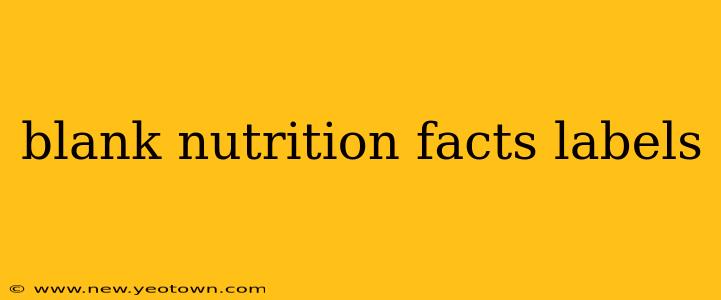The humble nutrition facts label. We see them every day, plastered on everything from cereal boxes to soda cans. But have you ever considered the power of a blank nutrition facts label? They're surprisingly versatile tools for various purposes, from recipe development and food journaling to educational projects and even marketing. This isn't just about filling in numbers; it's about understanding the crucial role these labels play and how you can leverage their blank canvas to achieve your goals.
Why Use a Blank Nutrition Facts Label?
Let's start with the "why." Why bother with a blank label when you can readily find filled-out examples? The answer lies in the flexibility they offer:
-
Recipe Creation and Analysis: Are you developing a new recipe? A blank label becomes your ultimate tracking tool. As you perfect your creation, you can meticulously record the nutritional information – per serving, of course! This ensures accuracy and allows for easy adjustments based on ingredient changes.
-
Food Journaling and Tracking: Forget generic calorie counters. A blank label lets you document the precise nutritional breakdown of your meals, meticulously calculated for your individual dietary needs and goals. This level of personalized data is invaluable for health-conscious individuals and those following specific diets.
-
Educational Purposes: Whether you're a teacher, a nutrition student, or simply passionate about food education, blank labels provide a hands-on approach to learning about nutrition. Students can fill in the information for different foods, fostering a deeper understanding of food composition.
-
Marketing and Product Development: For businesses, blank labels can be used to design mock-ups for new products, allowing for realistic visualization before committing to packaging design and production. It streamlines the process and prevents costly mistakes.
What Information Goes on a Nutrition Facts Label?
Before you start filling in those blanks, let’s refresh our collective memory on what information typically appears on a nutrition facts label. This will give you a solid foundation for creating accurate and informative labels.
-
Serving Size: This is crucial! The entire label is based on this single serving. Inconsistent serving sizes can lead to misleading nutritional information.
-
Servings Per Container: How many servings are in the entire package?
-
Amount Per Serving: This section details the quantity of various nutrients (calories, total fat, saturated fat, trans fat, cholesterol, sodium, total carbohydrate, dietary fiber, total sugars, added sugars, protein, vitamin D, calcium, iron, and potassium) per serving.
-
Percent Daily Value (%DV): This shows how much of a nutrient in a serving contributes to a daily diet. A good guide for determining if a serving is high or low in a particular nutrient.
Where Can I Find Blank Nutrition Facts Labels?
Luckily, finding blank nutrition facts labels is easier than you might think. A quick online search will reveal numerous websites offering free downloadable templates. You can also find them in various formats, from printable PDFs to editable digital versions.
How to Accurately Fill in a Blank Nutrition Facts Label?
Accuracy is paramount. To correctly fill in a blank nutrition label, you'll need a nutrition facts calculator, a food composition database, or a nutrition analysis software. There are numerous free and paid resources available online to assist in this process. Be meticulous, double-check your calculations, and ensure your data aligns with established guidelines.
Common Mistakes to Avoid When Filling Out a Blank Nutrition Facts Label
Even with the right tools, mistakes can happen. Here are a few common errors to watch out for:
-
Incorrect Serving Size: As mentioned earlier, this is the foundation of your label. An incorrect serving size will throw off all subsequent calculations.
-
Rounding Errors: Be precise with your calculations and use the correct rounding rules for nutrition labeling.
-
Misinterpreting Data: Always double-check your calculations and data sources to ensure accuracy.
By using blank nutrition facts labels thoughtfully and accurately, you unlock a world of possibilities, whether you're a culinary innovator, a dedicated health enthusiast, or an educator spreading nutrition knowledge. Remember, the power lies not in the blankness of the label but in the meaningful information you choose to fill it with.

